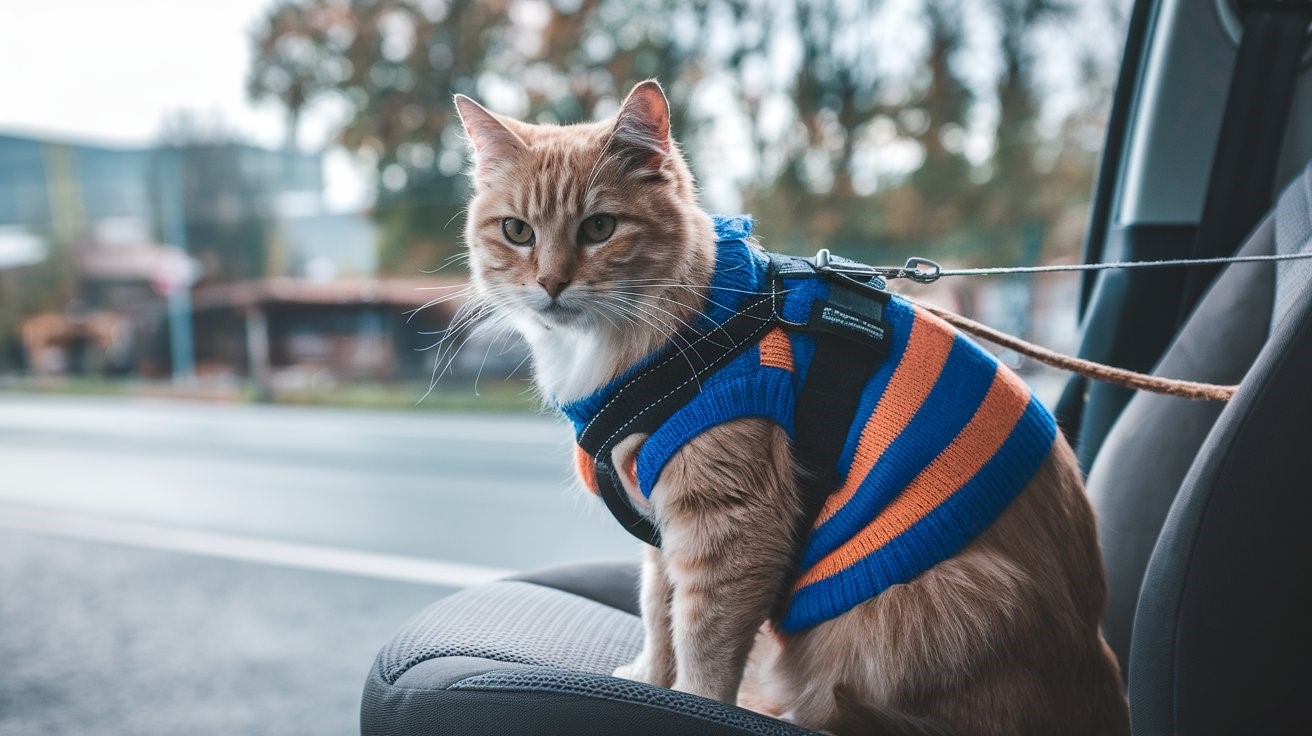If you’re road-tripping and you find yourself marveling at the question of how to take cats cross country? It is very important to plan when traveling with your cats and most importantly, to love them. Cats are very receptive animals and this fact requires their comfort during long trips.
There are services for your cats while you are on the move with them in transit. If you are not careful, trips can be quite a headache but if you plan well, it becomes an easy and fun affair. Safe pet transportation from Pub Mobile means cats are transported comfortably and safely.
Bringing your cat on vacation with a stress-free travel with your feline friend? Let’s discover how to keep your cat happy & safe on a cross-country journey. You will find everything in this guide, you need to know to make the trip comfortable for both you and your cat.
Start With a Vet Visit Before Hitting the Road
Make sure your cat is healthy to travel by visiting a veterinarian to capture any problem. Travel with your pet is different every time, so consult the vet to get specific information regarding this. Take the necessary vaccinations required and ask for drugs for stress or motion sickness where necessary.
This way your cat will be relaxed and also healthy on the date of the trip. Starting your journey with the confidence of a vet visit can be a good way to start.
Choose the Right Carrier for Comfort and Safety
Purchase a quality, sturdy built, and properly ventilated cage that will be safe for your cat. Make sure the carrier is large enough to let your cat twist and stretch their body. To make it more inviting add a soft blanket and a favorite toy to the bed.
Some may shift or slide during the process, and thus need to be anchored using a seat belt. This is why a quality carrier goes a long way in determining how to take cats cross country.
Familiarize Your Cat With Car Travel
To help your cat get used to traveling by car, take short trips with the pet before going on long journeys. The time taken in the drives ought to be progressively increased for the cat to become more comfortable.
There must not be the use of loudspeakers or else any form of provocation such as dancing. Alpride cohort, so the rewards such as treats and praise should be given after each ride. The concept of familiarization therefore makes long-distance travelling much easier for your feline friend.
Pack All the Essentials for the Journey
Pack food items, water, litter, and some of your cat’s favorite snacks in your car as your traveling kit. Ensure you have a travel for the litter box; some packaging bags and wet wipes for the inevitable cleaning sessions. For emergencies, it is wise to keep records of your cat’s medical history.
You will, however, need a leash or a harness when making a pit stop. Every car tool or equipment that is placed in an emergency kit should be properly packed to guarantee access to any of these upon the emergence of any problem on the road.
Create a Safe and Relaxing Travel Environment
It’s very important to regulate the temperature within the car, whether it should be hot or cold. Add yet another layer of modality to decrease stress by placing a thin sheet over the carrier to shut out external stimuli. Put the carrier at a location where there is no draft or direct sunlight, or close to an air conditioner.
If your cat seems stressed out, turn on some relaxing music or even use some pheromone sprays that will help to soothe your cat. Stress-free conditions ensure your cat is comfortable during the trip. ● To avoid unnecessary stress, give short breaks to let your cat drink and run around in a safe area.
- For increased safety during pit stops you should use a secure travel harness.
- In case you go for a long drive, you can carry along with you a pet camera or monitor to monitor your cats.
Stick to a Routine While on the Road
Try to stick to feeding and grooming your cat at the normal times that you would as closely as possible. Make an effort to stop the vehicle every two to three hours to allow the cat to relieve itself, stretch, and get some exercise.
Do not feed your cat just before you are planning to travel because it may affect motion sickness. Water, in small quantities at some interval or the other, should be encouraged for the kids. Routine minimizes the stress that your pet may likely encounter during travel.
Keep Safety a Priority Throughout the Trip
You should never leave your cat alone in the car even if only for a couple of minutes. Always make sure the carrier is anchored properly, and do not need to open it while traveling. During pit stops dogs should be on a leash and harness to avoid any possibility of escape.
Be sure to verify a hotel policy if you plan on spending a night in a particular hotel with your pet. Measures prevent your cat from stress and other dangers in the course of the journey.
Know How to Handle Common Travel Issues
It is advisable to discuss with the vet and be ready for other problems, such as motion sickness or anxiety. If your cat is on an appetite strike, try giving it some of the special kitty’s favorite snacks or wet food. Make sure you can easily recognize the symptoms of too much heat or even severe dehydration: excessive salivation, and rapid or heavy breathing.
If your cat looks confused or upset, do not panic, soothe the cat instead. Being proactive is useful in dealing with problems because it is the best offense that can be employed against a situation.
- Dealing With Motion Sickness: Features should include the provision of light meals as well as administering veterinary recommended anti-emetics.
- Managing Anxiety: It is recommended to introduce to the patient recognizable, comforting objects such as blankets, toys, etc.
- Recognizing Serious Issues: Look for symptoms that the cat is in pain, uncomfortable or sleepy, or unwilling to get up.
Plan Cat-Friendly Accommodations in Advance
The hotels that accept cats should be looked into and specific hotels should inquire about their pet policies. Choose areas of the airports that provide facilities for the pet; food, water, or toy, a place to defecate, or litter box supplies.
To avoid any unexpected issues, notify the accommodation about your cat in advance so you understand their pet policies. It is wise to restrain your cat to a safe area in the room in a bid to avoid disasters. Suitable cat housing seeks to create a cozy and secure space for your feline friends.
End the Journey With a Relaxing Arrival
Keep your cat mobile and let him minorities start to foster around this new environment. Hence you should provide them with an area where they can relax with their feeding and water bowels as well as their litter box.
Cats need more effective petting and play to help them feel secure that there is nothing to be afraid of. Pay attention to their behavior after the trip to see if they are stressed, uncomfortable, or complained about their experience or not. A peaceful arrival of the car is rewarding for both of you after a long drive.
Final Thoughts
This guide on how to take cats cross country emphasizes that traveling with felines is possible with proper preparation. Prioritize comfort, security, and a predictable routine to enhance your pet’s travel experience. Remember through your travels to always respect your cat’s needs and always make sure that you are patient with them.
Pet care from professional workers makes it easier to consider Pub Mobile while organizing an interstate car rental for a pet. It means they get you to enjoy your cat using premium pet treats during those long car rides.
Ready to get started? Contact Pupmobilellc@gmail.com or call 888-7104190.
FAQs:
- What should I do if my cat is traveling a long distance by car?
To counter this, the kitty should be taken in the car for short trips and these have to be done gradually. - What should I carry to a cross-country trip for a cat?
Some of the necessities and essentials that should be in the vehicle should be; food, water, a litter box, toys, and medical records. - When is it appropriate to pause the process of arriving?
Leaving your cat in the car every 2 to 3 hours to get some water and some exercise is acceptable. - What am I going to do if my cat gets sick on her feet or suffers from motion sickness?
A. There should be medication advised by the vet for your pet, and it’s advised that one should not feed before beginning a trip. - Is it safe for me to allow my cat to roam freely in the car?
No, always have your cat cramped in a carrier for their own sake. - I am frequently out of home and need my cat to be comfortable while in the hotel.
A. Create a room that is not noisy and should contain familiar objects such as a blanket and a litter box.









